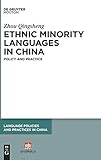Ethnic Minority Languages in China : Policy and Practice / Qingsheng Zhou.
Material type: TextSeries: Language Policies and Practices in China [LPPC] ; 5Publisher: Berlin ; Boston : De Gruyter Mouton, [2020]Copyright date: ©2020Description: 1 online resource (XXVII, 441 p.)Content type:
TextSeries: Language Policies and Practices in China [LPPC] ; 5Publisher: Berlin ; Boston : De Gruyter Mouton, [2020]Copyright date: ©2020Description: 1 online resource (XXVII, 441 p.)Content type: - 9781501515026
- 9781501511516
- 9781501511837
- 306.44951 23
- online - DeGruyter
- Issued also in print.
| Item type | Current library | Call number | URL | Status | Notes | Barcode | |
|---|---|---|---|---|---|---|---|
 eBook
eBook
|
Biblioteca "Angelicum" Pont. Univ. S.Tommaso d'Aquino Nuvola online | online - DeGruyter (Browse shelf(Opens below)) | Online access | Not for loan (Accesso limitato) | Accesso per gli utenti autorizzati / Access for authorized users | (dgr)9781501511837 |
Frontmatter -- Acknowledgments -- Contents -- List of Figures -- List of Tables -- Part 1: Overview -- Chapter 1 The social language situation in China -- Chapter 2 Requiring Putonghua as the common language and encouraging ethnolinguistic diversity: The development of language policy in China -- Part 2: Language life -- Chapter 3 The composition of the bilingual population in China -- Chapter 4 Language, ethnicity, and identity in China -- Chapter 5 The language situation of ethnic group in the transborder regions of China -- Chapter 6 An investigation into bilingualism in Dehong Dai -- Chapter 7 Language change and economic and social transition: The case of the Gin in China -- Part 3: Language variation and change -- Chapter 8 Overview of language variation -- Chapter 9 The categories of language variation -- Chapter 10 Variation of kinship terms in Dai -- Chapter 11 Hierarchical structures and social functions of personal names in the Dai ethnic group -- Part 4: Language maintenance -- Chapter 12 Language loss and language maintenance: The example of Tungus -- Part 5: Language policies and practices -- Chapter 13 Language policies and practices for ethnic groups introduced by the Kuomintang and the Communist Party of China during the National Government period (1927–1949) -- Chapter 14 Ethnic language policies and their implementation during the reform and opening-up period -- Chapter 15 Comparison of language laws in Tibet and Xinjiang -- Chapter 16 Challenges and opportunities for ethnic minority languages in a time of social transformation -- Part 6: Innovation in and reform of writing systems -- Chapter 17 The creation of writing systems and nation-building -- Chapter 18 The creation and trial implementation of the Eastern Guizhou Miao writing system -- Chapter 19 Three major reforms of writing systems in Xinjiang and Mongolia -- Chapter 20 Assessment of the theory and practice of the standardization of the Yi writing system -- Part 7: Bilingual education and motivations for second language acquisition -- Chapter 21 The development and problems of bilingual education in China -- Chapter 22 Types of bilingual education in China -- Chapter 23 A report on transitions between bilingual teaching models in China -- Chapter 24 Three transitions in ethnic minority language teaching models -- Chapter 25 Comparison of the motivations for second language acquisition among ethnic children -- Part 8: Conclusion -- Chapter 26 Constructing a harmonious language life -- References -- Index
restricted access online access with authorization star
http://purl.org/coar/access_right/c_16ec
This book describes and analyzes the situation of minority languages in China.
Issued also in print.
Mode of access: Internet via World Wide Web.
In English.
Description based on online resource; title from PDF title page (publisher's Web site, viewed 25. Jun 2024)


